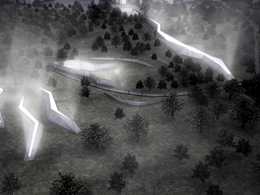STUDENTS PROJECTS
PROJECTS2012

13 May, 2013
Cracks in the park
In this project the goal is to study the urban gap that appears in the SE gate of Thessaloniki and to design it in an environmentally friendly way.
Student : Nikoleta - Maria Christopoulou
Supervisor Stavros Vergopoulos
Aristotle University of Thessaloniki
Presentation date : July 2012
Introduction
The desing diploma thesis was supervised under Mr Stavros Vergopoulos, Assistant Proffessor in the Architectural Department of Aristotle University of Thessaloniki. The main target was to study and design a big urban gap which appears in the SE entrance of the city.

Object
The main object of the thesis has been the research on design methods which would succeed an environmentally friendly intervention and provide scenery changes of the site throughout the year (pic.3 right side). The arrangement of the existing building, the bus and the subway terminal that is planned to be placed to the site, a new parking lot, as well as a number of activities, such as leisure and recreation areas, sports areas and a shopping center were the main challenges of the thesis. This urban gap, where local stockyards appear, interrupts the consolidation of the urban web and concistutes a source of infection and pollution at the same time.

Data
The project is located in the borders of Charilaou,Pylaia and Kalamaria. Papanastasiou, Allatini, Voulgari, K.Karamanli streets and the National higway that connects Thessaloniki and Chalkidiki are the borders of the intervention area. Evrigeni and Ypsilantou streets interrupt the consolidation of the site. The regional moat enters the study area, while the stream of Kalamaria appears nearby. The old tiles factory named "Allatini" and the park of N.Elvetia, beneath the latter of which the terminal of the subway will be built, consist the strongest points of the area. Noise from cars and local stockyards, pollution and the lack of plan of green spaces weaken the character of the are.

Intentions-concept
The primary intention is to create a metropolitan park by consolidating the given space, as well as recalling the memory of the stream and spreading the character of the park to the surrounding area (pic.3 left side). To achieve the aforementioned goals a natural sound barrier is created in the eastern side of the park, Ypsilantou and Evrigeni streets stop when they reach the borders of the park, while Psellou street is opened underground. The subway station, cafes, bike rental, commercial and sports areas are spatially organised, while the old factory is being reused as a cultural center. A net of pedestrian ways, the ends of which are the open accesses to the park, and loops of cycle ways move together or autonomously, so as to cover the bigger part of the park the possible. Finally, a residential area in the park is also forcast (pic.3 left side). The pedestrian and the cycle ways , as well as the planting plans are based on diagrams of thickening and thinning. The last ones were created from diagramms of the annual wind directional distribution in the area that were translated in diagrams of height and depth.


The plants follow the movements in the park and they are enhanced or weakened depending on the intensity of the movement at the point. The design methods in large scale are based conceptually on the crack, which actually means sections in the ground. The subway is the reason for this choice. As a power that comes from underground, it leads the ground to rupture, peeling and in the eventual revelation of the force that created it. In order to understand the function of the crack and get familiar with its lines, architectural models were constructed either by hands or digitally.


The first ones helped me understand the connection between inner and outer, upper and spaces below. The second ones helped me familiarise with the lines of the crack so as to achieve the desired goals in the design process. That led to the creation of vertical and horizontal sections on the ground in order to accommodate the facilitites needed. The vertical section brings shining light in the inside, and in combination with the diverse shape of the crack, it creates unique ambiance. The shells that accommodate the rest of the facilities are formed by the lines and forms that are created by the surficial rupture of a material; in this case, the ground. Diverse shapes swell upwards creating a recess on the bottom side. The masterplan shows the final location of the facilities in the park. In the terminal of the subway it is now obvious that the communication responds to two dipoles; In-out and up-down. The vertical section provides the space with diffusing light, which in combination with the diverse shape of the roof creates an almost natural ambiance. In the sports area the changing rooms have been placed underground. The light gets into the space through vertical sections. In the cafeteria the interior communicates with the outter space from its unique frontview. Nevertheless, in the shopping center the shops are located on the sides of a central movement of the users. The light follows the movement and creates interesting shadows on the walls during the day. Finally, in an effort to respect the history of the old tiles factory "Allatini", cracks that embrace the building were created and hidden light was added in order to highlight the building at night

Closure
The vertical and horizontal sections, the games with light, and the diverse shapes of the shells create a dialog between built and natural, earth and building, under- and overground. Hybrid models (bulding-ground) are created to accommodate the facilities, that will intergrate to the environment in time when the plants will grow and climb on the building components.
This research provided me with new tools and techniques for capturing, proccessing and realizing a concept.












